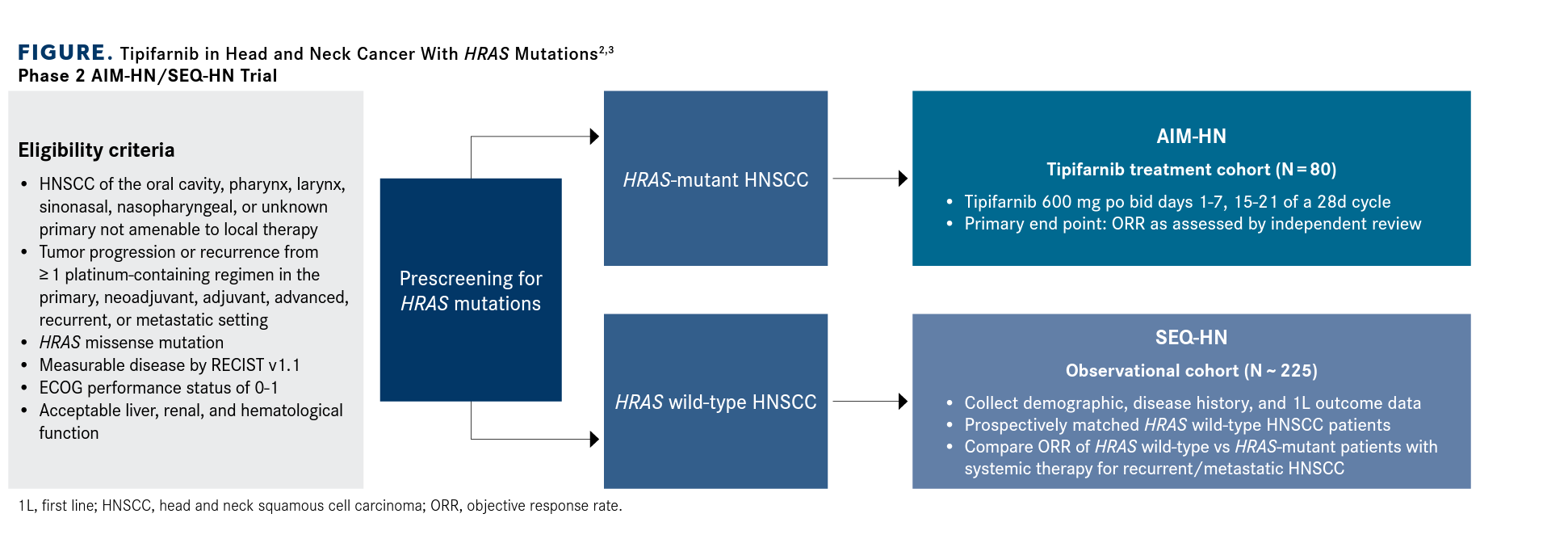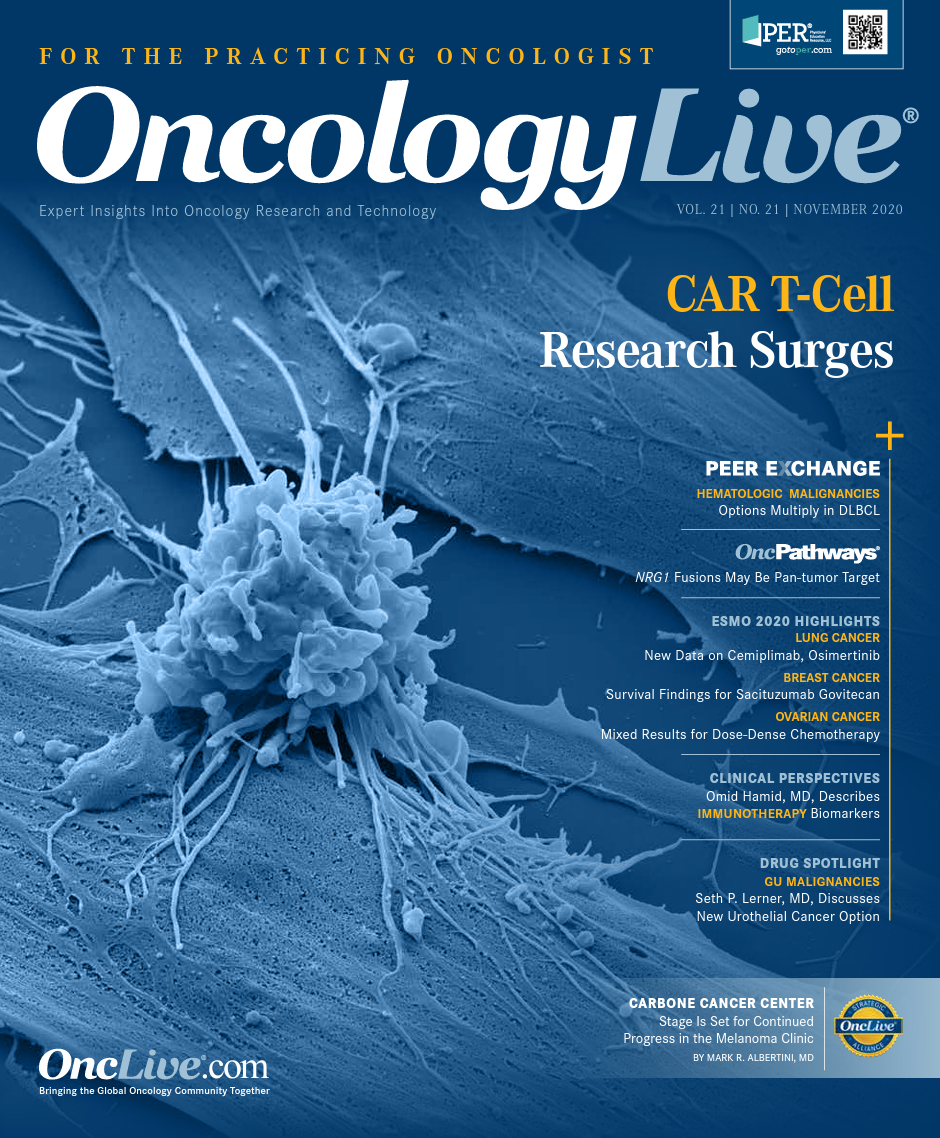Tipifarnib Shows Potential in HRAS-Mutant Head and Neck Cancers
Investigators are testing tipifarnib, a novel drug that inhibits a critical enzyme needed for HRAS activation, in patients with head and neck squamous cell carcinoma whose tumors harbor the mutation.
Alan L. Ho, MD, PhD

Although the role of HRAS mutations in a range of cancers was discovered more than 40 years ago,1 targeting the alterations has proved challenging. Now, investigators are testing tipifarnib, a novel drug that inhibits a critical enzyme needed for HRAS activation,1 in patients with head and neck squamous cell carcinoma (HNSCC) whose tumors harbor the mutation.
The AIM-HN/SEQ-HN trial (KO-TIP-007; NCT03719690) is an ongoing registrational, phase 2 study assessing the objective response rate (ORR) of tipifarnib in patients with incurable HRASmutant HNSCC. The international study was launched after tipifarnib demonstrated signs of efficacy in this patient population during a basket trial, according to Alan L. Ho, MD, PhD, a leading investigator of the drug.
“We were testing tipifarnib in HRAS [mutation-positive tumors] in several malignancies and found this particularly intriguing signal in HRAS patients with head and neck cancer,” Ho said in an interview with OncologyLive®.
“Broadly speaking for head and neck cancer, it has been an exciting time for treatment for these patients with the advent of immunotherapy. But for patients with recurrent or metastatic disease, this is still an incurable disease and one where there is still a huge need for therapeutics,” said Ho, a medical oncologist at Memorial Sloan Kettering Cancer Center in New York, New York.
Investigators are seeking to enroll 305 patients (80 HRAS mutant HNSCC for AIM-HN and SEQ-HN; 225 HRAS with HNSCC for SEQ-HN), which is recruiting at 95 locations in the United States, Europe, Australia, and Asia Pacific nations. Patients eligible for the study include those with HNSCCs of the oral cavity, pharynx, larynx, sinonasal, nasopharyngeal, and unknown primary. Those with salivary gland, thyroid, and primary cutaneous squamous or nonsquamous histologies such as mucosal melanoma are excluded.
The study has 2 cohorts: AIM-HN (n = 80), including 59 with high variant allele frequency (VAF) HRAS mutations and 21 with low VAF HRAS mutations, and SEQ-HN (n = 225). In AIM-HN, patients with HRAS-mutant HNSCC will receive tipifarnib monotherapy twice a day orally at 600 mg on days 1 to 7 and days 15 to 21 of 28-day treatment cycles.
The primary end point is the ORR in high VAF HRAS-mutant HNSCC. Secondary end points are ORR among HRAS-mutant HNSCC of any VAF, duration of response (DOR), time to response, and progression-free survival (PFS), as well as safety/tolerability, effects of tipifarnib on quality of life, and time to progression. SEQ-HN is a parallel prospective observation cohort that will compare treatment outcomes with first-line systemic therapy and other demographic/clinical characteristics in patients with HRAS- mutant HNSCC who enrolled in AIM-HN and a matched control set of patients with HRAS wild-type tumors (FIGURE).2,3
FIGURE. Tipifarnib in Head and Neck Cancer With HRAS Mutations2,3

Mechanism of Action
Tipifarnib is a small molecule inhibitor of farnesyltransferase, an enzyme involved in the posttranslational modification of the RAS family proteins, which include HRAS, NRAS, and KRAS.4 Dysregulated activity of this signaling network has been implicated in approximately 30% of human cancers.5 In HNSCCs, HRAS is mutated in approximately 6% of tumors and is overexpressed in 30%, Ho said during a presentation at the 2020 American Society of Clinical Oncology Virtual Scientific Program.
These mutations also are found in 2% of lung squamous cell carcinoma and 5% of urothelial carcinoma, whereas overexpression in those cancer types is 8% and 25%, respectively.6
During the past 20 years, investigators have sought to develop farnesyltransferase inhibitors (FTIs) for RAS-mutant cancers, Ho said.
“It was based on the understanding that all RAS isoforms including mutant RAS required localization to the membrane in order to activate its downstream signaling and to promote oncogenesis,” he said. “The idea was if you could inhibit that enzyme, you could delocalize RAS from the membrane and extinguish its signaling, and that would be a way to kill these RAS-mutant tumors.”
Although FTIs exhibited promise in preclinical studies, data from phase 2 and 3 trials showed modest outcomes.7 Ho said it was later discovered that other mechanisms come into play that maintain RAS localization in the membrane. HRAS mutations, he said, may be more susceptible to FTIs.
Tipifarnib is an FTI initially studied extensively in the late 1990s and early 2000s but did not achieve response rates robust enough to support registrational studies.8 More than 5000 patients have been treated with tipifarnib, and although the agent has demonstrated responses in several tumor types, its mechanisms of action were not well understood.1
Since then, the use of next-generation sequencing has been able to identify specific driver mutations in patient populations.8 Tipifarnib is currently the only FTI under investigation for HRAS-dependent HNSCC, according to Kura Oncology, the company developing the drug.4
Recent Early-Phase Findings
The rationale for testing tipifarnib in HRASmutant HNSCC stems from findings from the phase 2 KO-TIP-001 trial (NCT02383927)that evaluated the agent in patients with solid tumors with a mutation.
For the head and neck cohort, HRAS positivity was defined as a missense mutation with a VAF of 20% or greater and serum albumin of 3.5 g/dL or greater or HRAS VAF of 35% or greater.
In 18 evaluable patients, treatment with tipifarnib resulted in a 50.0% ORR (95% CI, 26.0%-74.0%) with a median DOR of 14.7 months (95% CI, 2.1-not reported). The median PFS was 5.9 months (95% CI, 3.5-19.2), and median OS was 15.4 months (95% CI, 7.0-46.4).6
In a cohort of 12 evaluable patients with recurrent, metastatic HRAS-mutant salivary gland cancer, 1 patient achieved a partial response with tipifarnib therapy (8.3%) and 7 reached stable disease (58.3%).
In addition to HNSCC, tipifarnib was studied in a phase 2 trial (NCT02535650) in patients with previously treated, metastatic urothelial cancer with missense HRAS mutations or STK11 single nucleotide variant. The ORR in 21 patients who received tipifarnib therapy was 24% (95% CI, 6%-42%); no response was observed in patients with wild-type HRAS tumors.9
The median PFS was 4.7 months (95% CI, 2.5-5.6), and median OS was 6.1 months (95% CI, 5.0-7.2).9
The most frequently observed adverse effects included fatigue (86%), anemia (76%), and neutropenia (67%).
Future Directions
The FDA has approved fast track designations for tipifarnib in HRAS-mutant HNSCC and adult patients with relapsed or refractory T-cell lymphomas including angioimmunoblastic T-cell lymphoma (AITL), follicular T-cell lymphoma, and nodal peripheral T-cell lymphoma with T follicular helper phenotype.10,11
Clinical data reported at the 2019 American Society of Hematology Annual Meeting showed durable activity from tipifarnib as a monotherapy in relapsed or refractory AITL in an ongoing single-arm phase 2 study (KO-TIP-002; NCT02464228). The ORR was 50% (95% CI, 28%-72%) in 20 evaluable patients with AITL and 70% (95% CI, 36%-93%) in 10 patients with KIR-mutated AIT.12
References
- Ho A, Chau N, Wong DJ, Cabanillas ME, et al. Preliminary results from a phase 2 proof of concept trial of tipifarnib in tumors with HRAS mutations. Mol Cancer Ther. 2018;17 (suppl 1). LB-A10. doi:10.1158/1535-7163.TARG-17-LB-A10
- Safety and efficacy of tipifarnib in head and neck cancer with HRAS mutations and impact of HRAS on response to therapy (AIM-HN/SEQ-HN). ClinicalTrials.gov. Updated December 23, 2019. Accessed October 5, 2020. https://clinicaltrials.gov/ct2/show/NCT03719690
- Haddad RI, Harrington KJ, Licitra LF, et al. The AIM-HN and SEQHN study: a pivotal study evaluating the efficacy of tipifarnib in patients with head and neck squamous cell carcinoma (HNSCC) with hras mutations (AIM-HN) and the impact of hras mutations on response to first-line systemic therapy for HNSCC (SEQ-HN). J Clin Oncol. 2020;38(suppl 15). doi:10.1200/JCO.2020.38.15_ suppl.TPS6593
- A farnesyltransferase inhibitor study. Kura Oncology. Accessed October 5, 2020. https://bit.ly/3nk3QUB
- Takashima A, Faller DV. Targeting the RAS oncogene. Expert Opin Ther Targets. 2013;17(5):507-531. doi: 10.1517/14728222.2013.764990
- Ho AL, Hanna GL, Scholz CR, Gualberto A, Park SH. Preliminary activity of tipifarnib in tumors of the head and neck, salivary gland, and urothelial tract with HRAS mutations. J Clin Oncol. 2020;38(suppl 15):6504. doi:10.1200/ JCO.2020.38.15_suppl.6504
- Brunner TB, Hahn SM, Gupta AK, Muschel RJ, McKenna WG, Bernhard EJ. Farnesyltransferase inhibitors: an overview of the results of preclinical and clinical investigations. Cancer Res. 2003; 63(18)5656-5668
- Gilardi M, Wang Z, Proietto M, et al. Tipifarnib as a precision therapy for HRAS-mutant head and neck squamous cell carcinomas. Mol Cancer Ther. 2020;19(9):1784-1796; doi:10.1158/1535-7163.MCT-19-0958
- Lee J, Kim H, Gualberto A, Scholz CR, Park SH. Tipifarnib, a farnesyltransferase inhibitor, for metastatic urothelial carcinoma harboring HRAS mutations. J Clin Oncol. 2020;38 (suppl 15):5086. doi:10.1200/JCO.2020.38.15_suppl.5086
- Kura Oncology receives fast track designation for tipifarnib in HRAS mutant HNSCC and provides enrollment guidance for AIM-HN trial. News release. Kura Oncology. December 16, 2019. Accessed October 5, 2020. https://bit.ly/3nhSksV
- Kura Oncology receives fast track designation for tipifarnib in T-cell lymphomas. News release. Kura Oncology. March 2, 2020. Accessed October 6, 2020. https://bit.ly/3lhsJOT
- Witzig TE, Sokol L, Foss FM, et al. Proof of concept for tipifarnib in relapsed or refractory angioimmunoblastic T-cell lymphoma (AITL) and CXCL12+ peripheral T-cell lymphoma (PTCL): preliminary results from an open-label phase 2 study. Blood. 2019;134(suppl 1):468. doi:/10.1182/blood-2019-128513




